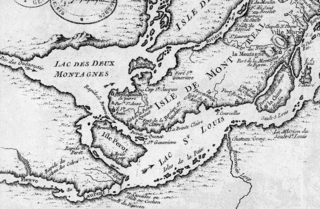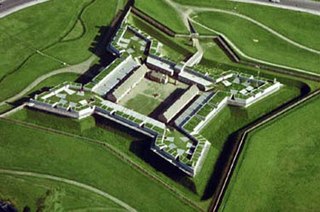
The American Revolution was a rebellion and political movement in the Thirteen Colonies which peaked when colonists initiated an ultimately successful war for independence against the Kingdom of Great Britain. Leaders of the American Revolution were colonial separatist leaders who originally sought more autonomy as British subjects, but later assembled to support the Revolutionary War, which ended British colonial rule over the colonies, establishing their independence as the United States of America in July 1776.

The Invasion of Quebec was the first major military initiative by the newly formed Continental Army during the American Revolutionary War. The objective of the campaign was to seize the Province of Quebec from Great Britain, and persuade French-speaking Canadiens to join the revolution on the side of the Thirteen Colonies. One expedition left Fort Ticonderoga under Richard Montgomery, besieged and captured Fort Saint-Jean, and very nearly captured British General Guy Carleton when taking Montreal. The other expedition, under Benedict Arnold, left Cambridge, Massachusetts, and traveled with great difficulty through the wilderness of Maine to Quebec City. The two forces joined there, but they were defeated at the Battle of Quebec in December 1775.

The Battle of Oriskany was a significant engagement of the Saratoga campaign of the American Revolutionary War, and one of the bloodiest battles in the conflict between Patriot forces and those loyal to Great Britain. On August 6, 1777, several hundred of Britain's Indigenous allies, accompanied by Loyalists of the King's Royal Regiment of New York and the British Indian Department, ambushed a Patriot militia column which was marching to relieve the siege of Fort Stanwix. This was one of the few battles in which the majority of the participants were American colonists. Patriots and allied Oneidas fought against Loyalists and allied Iroquois and Mississaugas. No British regulars were involved; however, a detachment of Hessians was present.

The Oneida people are a Native American tribe and First Nations band. They are one of the five founding nations of the Iroquois Confederacy in the area of upstate New York, particularly near the Great Lakes.

Joseph Plumb Martin was a soldier in the Connecticut Militia and Continental Army during the American Revolutionary War, and was mustered out as a 23-year-old Sergeant in a Sapper company. His published narrative of his experiences, re-discovered in the 1950s, has become a valuable resource for historians in understanding the conditions of a common soldier of that era, as well as the battles in which Martin participated.

The Battle of the Cedars was a series of military confrontations in the early stages of the American Revolutionary War that occurred during the Continental Army's invasion of Quebec, which began in September 1775. These skirmishes, which involved limited combat, occurred in May 1776 at and around the Cedars, 45 km (28 mi) west of Montreal, Quebec. Continental Army units were opposed by a small British Army detachment leading a larger force of Haudenosaunee warriors and Canadian Militia.

Colonel Marinus Willett was an American military officer, politician and merchant who served as the mayor of New York City from 1807 to 1808. Willett is best known for his actions during the American Revolution, where he served as an important Patriot leader in colonial New York before enlisting in the Continental Army and serving in numerous campaigns in the Revolutionary War throughout the Northwest.
Johannes Justus Schuyler was a Tory with patriot roots, who was used by American General Benedict Arnold to repel the British and Indian forces of Colonel Barry St. Leger and Joseph Brant from their siege of Fort Stanwix following the Battle of Oriskany during the American Revolution.

Valley Forge was the winter encampment of the Continental Army, under the command of George Washington, during the American Revolutionary War. The Valley Forge encampment lasted six months, from December 19, 1777, to June 19, 1778. It was the third and harshest of the eight winter encampments that Washington and the Continental Army endured during the war.
The Battle of Ridgefield was a series of American Revolutionary War skirmishes in Danbury, Connecticut and Ridgefield, Connecticut.
Polly Cooper was an Oneida woman from the New York colony who took part in a expedition to aid the starving Continental Army during the American Revolutionary War. She was among 47 Oneida and Seneca people who carried bushels of corn 250 miles (400 km) to Valley Forge from late April into May 1778. She taught them how to make a soup with the corn, nuts, and fruits to increase its nutritional value. Not wanting to be paid for her service, she was presented with a black shawl, which has been esteemed by Cooper and the Oneida people. It has been loaned to the Oneida Nation Cultural Center. Cooper is depicted in a bronze statue, "Allies in War, Partners in Peace", made by Edward Hlavka. It is on display at the National Museum of the American Indian of the Smithsonian Institution.
John Skenandoa, also called Shenandoah among other forms, was an elected chief of the Oneida. He was born into the Iroquoian-speaking Susquehannocks, but was adopted into the Oneida of the Iroquois Confederacy. When he later accepted Christianity, he was baptized as "John", taking his Oneida name Skenandoa as his surname. Based on a possible reconstruction of his name in its original Oneida, he is sometimes called "Oskanondonha" in modern scholarship. His tombstone bears the spelling Schenando.

The Siege of Fort Stanwix began on August 2, 1777 and ended on August 22, 1777. Fort Stanwix, at the western end of the Mohawk River Valley, was a primary defense point for the Continental Army against the British and indigenous forces aligned against them during the American Revolutionary War. The fort was occupied by Continental Army forces from New York and Massachusetts under the command of Colonel Peter Gansevoort. The besieging force was composed of British regulars, Loyalist soldiers, Hessians, and indigenous warriors, under the command of Brigadier General Barry St. Leger. St. Leger's expedition was a diversion in support of Lieutenant General John Burgoyne's campaign to take control of the Hudson River Valley to the east.

Louis Cook, or Akiatonharónkwen (Mohawk), was an Iroquois leader and commissioned officer in the Continental Army during the American Revolution. Born to an African father and an Abenaki mother in what is now Schuylerville, New York, he and his mother were taken captive in a French-Mohawk raid and taken to Kahnawake, a Mohawk village south of Montreal. They were adopted by a Mohawk family. His mother soon died and he served Catholic missionaries, learning French. He became an influential leader among the Mohawk and distinguished himself as a warrior for their allies the French during the French and Indian War.
Louis Saint Ange Morel, chevalier de la Colombe (1755–1825) was an aide de camp to Gilbert du Motier, marquis de Lafayette, during the Revolutionary War.
Tyonajanegen was an Oneida woman who fought in the August 6, 1777 Battle of Oriskany during the American Revolutionary War. Armed with two pistols, she rode into battle and fought alongside her husband, Han Yerry, and her son, Cornelius. Tyonajanegen helped her husband reload his gun after a musket ball struck him in the wrist. After the battle she rode on horseback to bring news of the outcome to local rebels and Indians.
The following bibliography includes notable books concerning the American Revolutionary War. These books are listed in the bibliographies of books by prominent historians as shown in the footnotes.
Han Yerry is also known by Honyere Doxtator and his native name, Tewahangarahken. As a child, Han Yerry lived with a German-Dutch couple, who educated him and taught him the white people's culture. Over his life, he was a warrior, war chief, commissioned American Army officer, farmer, rancher, and caterer. He made a name for himself in the American Revolutionary War and is one of three great ancestors of Oneida people who served as commissioned officers in the war. Hon Yerry received 1,800 acres in land grants for his service. He was a gentle man, distinguished soldier, leader, man of his word, and heroic.
Paul Powless Tegahsweangalolis was a warrior and chief of the Oneida people and hereditary sachem of the Bear clan. Like many of his people, he joined the American side during the Revolutionary War and served as a spy and messenger.










